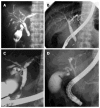Inflammatory bowel disease of primary sclerosing cholangitis: a distinct entity?
- PMID: 24696608
- PMCID: PMC3964396
- DOI: 10.3748/wjg.v20.i12.3245
Inflammatory bowel disease of primary sclerosing cholangitis: a distinct entity?
Abstract
This is a review of the characteristic findings of inflammatory bowel disease (IBD) associated with primary sclerosing cholangitis (PSC) and their usefulness in the diagnosis of sclerosing cholangitis. PSC is a chronic inflammatory disease characterized by idiopathic fibrous obstruction and is frequently associated with IBD. IBD-associated with PSC (PSC-IBD) shows an increased incidence of pancolitis, mild symptoms, and colorectal malignancy. Although an increased incidence of pancolitis is a characteristic finding, some cases are endoscopically diagnosed as right-sided ulcerative colitis. Pathological studies have revealed that inflammation occurs more frequently in the right colon than the left colon. The frequency of rectal sparing and backwash ileitis should be investigated in a future study based on the same definition. The cholangiographic findings of immunoglobulin G4-related sclerosing cholangitis (IgG4-SC) are similar to those of PSC. The rare association between IBD and IgG4-SC and the unique characteristics of PSC-IBD are useful findings for distinguishing PSC from IgG4-SC.
Keywords: Immunoglobulin G4-related sclerosing cholangitis; Inflammatory bowel disease; Inflammatory bowel disease-associated with primary sclerosing cholangitis; Primary sclerosing cholangitis.
Figures




References
-
- Lazaridis KN, Wiesner RH, Porayko MK, Ludwig J, LaRusso NF. Primary sclerosing cholangitis. In: Schiff ER, Sorrel MF, Maddrey WC, editors. Schiff’s disease of the liver. English Edition. Philadelphia: Lippincott-Raven; 1999. pp. 649–678.
-
- Lindor KD, LaRusso NF. Primary sclerosing cholangitis. In: Schiff L, Schiff ER, editors. Schiff’s disease of the liver. 9 ed. Philadelphia: JB Lippincott; 2003. pp. 673–684.
-
- Boonstra K, van Erpecum KJ, van Nieuwkerk KM, Drenth JP, Poen AC, Witteman BJ, Tuynman HA, Beuers U, Ponsioen CY. Primary sclerosing cholangitis is associated with a distinct phenotype of inflammatory bowel disease. Inflamm Bowel Dis. 2012;18:2270–2276. - PubMed
-
- Joo M, Abreu-e-Lima P, Farraye F, Smith T, Swaroop P, Gardner L, Lauwers GY, Odze RD. Pathologic features of ulcerative colitis in patients with primary sclerosing cholangitis: a case-control study. Am J Surg Pathol. 2009;33:854–862. - PubMed
-
- Nakazawa T, Naitoh I, Hayashi K, Okumura F, Miyabe K, Yoshida M, Yamashita H, Ohara H, Joh T. Diagnostic criteria for IgG4-related sclerosing cholangitis based on cholangiographic classification. J Gastroenterol. 2012;47:79–87. - PubMed
Publication types
MeSH terms
Substances
LinkOut - more resources
Full Text Sources
Other Literature Sources
Medical

